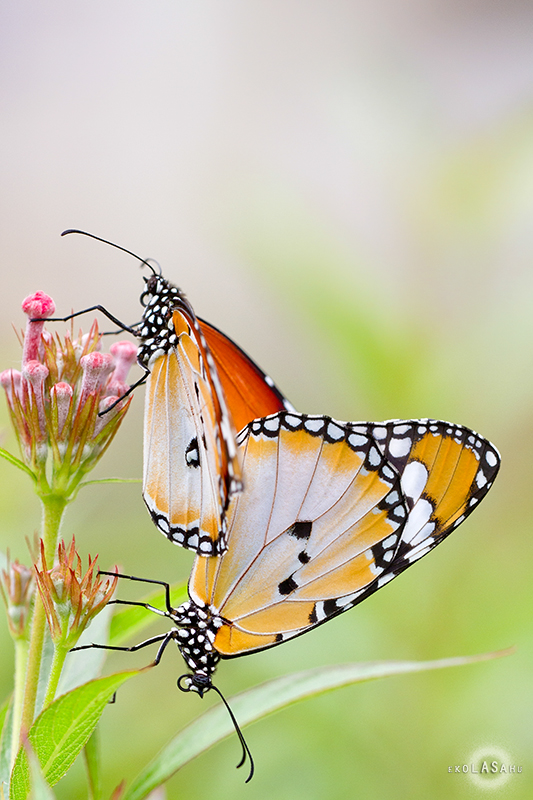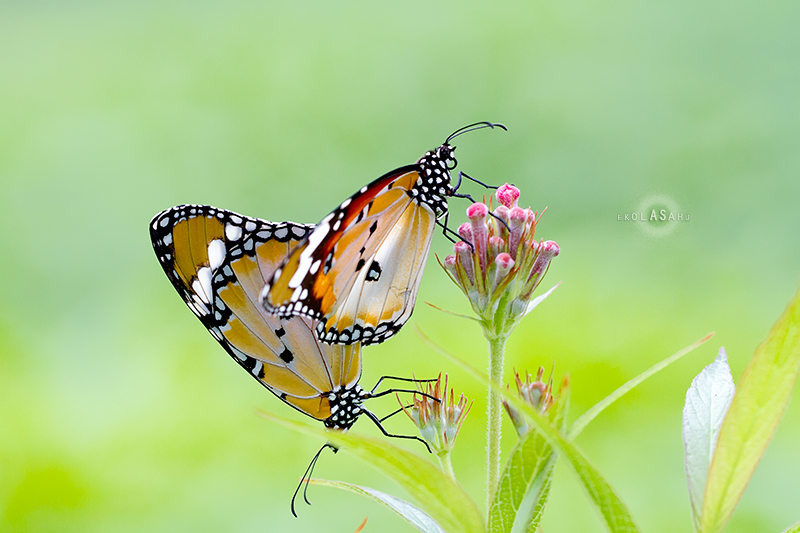In the 1820s, several paintings believed to be about 3500 years old were discovered in an Egyptian tomb in Thebes — the tomb of Nebamun— and subsequently acquired by the British Museum. Perhaps by virtue of its striking appearance, the Plain Tiger, or Danaus chrysippus (Linnaeus, 1758), as it is scientifically known, was one of the several different fauna depicted in these paintings; this is remarkable because it could very well be the earliest known record of a butterfly species in art. While living in Singapore in 2011, I had the opportunity to observe and photograph several individuals of this species.
One does not usually expect to find much by way of flora or fauna in the heart of a busy city, but I was pleasantly surprised one Sunday afternoon when, after church, I noticed a flutter of butterflies over a small patch of greenery that could not have been more than 20 square metres in size, right beside a busy MRT station in downtown Singapore. Happily for me, I was carrying my camera that day; in the span of about 15 minutes I was able to get a few quick pictures of several Plain Tigers. It was a cloudy day, and the naturally diffused lighting was perfect.
These brightly coloured butterflies are widespread throughout Africa as well as in most of Asia, the south Pacific Islands, and Australia. They frequent open areas and are unlikely to be found in heavily forested regions. As a child, I enjoyed watching these butterflies — they are so common as to be ubiquitous in many parts of India — particularly in the evenings, when they would find a low perch where they would spend the night. I’d watch them bask during the day, wings outspread so as to take in the sun’s warm goodness.
Currently, there are 3 accepted subspecies:
- Danaus chrysippus chrysippus (Linnaeus, 1758)
- Danaus chrysippus alcippus (Cramer, 1777)
- Danaus chrysippus orientis (Aurivillius, 1909)
The individuals in these pictures are D. c. chrysippus, the subspecies found in Asia.
The caterpillars of this species can be found on various species of milkweed (genus Asclepias). They too have bright markings, except that in their case the markings are yellow, as opposed to orange in the adult butterflies. The life cycle of the Plain Tiger has been beautifully described, along with pictures for reference, by Horace Tan on his wonderful blog, Butterflies of Singapore.
One interesting characteristic of this species is that the caterpillars accumulate toxins from the leaves that they feed on, making them (and the adult butterfly forms) poisonous, or at least distasteful to predators, who quickly learn to avoid them, associating their inedibility with their colours and patterns. This leads us to what can sometimes be quite a complex ecological system known as Batesian mimicry: a passive form of mimesis where a certain edible species deters predators as a result of being visually similar or almost identical to an inedible species, as well as displaying similar behaviour. The Plain Tiger is one such inedible model, mimicked by several other species, such as female Tropical Fritillaries (Argynnis hyperbius) and the Diadem (Hypolimnas misippus).
I do not fully believe in evolution: while I know full well that organisms are gradually and constantly evolving, I simply cannot accept the idea that the marvellously complex and intricate systems in nature simply came to be.The case of the Plain Tiger and its mimics is an excellent example of these remarkable connections between organisms and their environments. I believe that there must have been, and has to be, a Creator.
EDIT
A conversation with a friend on Facebook (Marino Linić) led me to a better understanding of the term evolution. The two processes I had assumed to be synonymous with evolution are actually quite different: they are rightly known as adaptation and natural selection, and are quite clearly NOT synonymous with evolution, although it is easy to get them mixed up.
Having said this, I would rewrite the final paragraph of the original article thusly:
I do not believe in evolution. I know full well that organisms adapt to their environment, and that populations of species can change as a result of natural selection. I simply cannot accept the idea that evolution brought about changes from simple molecules to the marvellously complex and intricate systems found in nature. The case of the Plain Tiger and its mimics is an excellent example of these remarkable connections between organisms and their environments. I believe that there must have been, and that there is, a Creator.
References:
- Bates, H. (1866). Contributions to an insect fauna of the Amazon Valley. 1st ed. London: Taylor and Francis.
- Boppré, M. (1986). Insects pharmacophagously utilizing defensive plant chemicals (pyrrolizidine alkaloids). Naturwissenschaften, 73(1), pp.17–26.
- Edgar, J., Boppré, M. and Schneider, D. (1979). Pyrrolizidine alkaloid storage in African and Australian danaid butterflies. Experientia, 35(11), pp.1447–1448.
- Parkinson, R. (2008). The painted tomb-chapel of Nebamun. Egyptian Archaeology, pp.21-24.
- Smith, D. (1973). Batesian mimicry between Danaus chrysippus and Hypolimnas misippus (Lepidoptera) in Tanzania. Nature Publishing Group.
- Smith, D., Lushai, G. and Allen, J. (2005). A classification of Danaus butterflies (Lepidoptera: Nymphalidae) based upon data from morphology and DNA. Zoological Journal of the Linnean Society, 144(2), pp.191–212.
- Tan, H. (2010). Life History of the Plain Tiger. [online] Butterflies of Singapore: Featuring Nature’s Flying Jewels in Singapore!. Available at: http://butterflycircle.blogspot.com/2010/11/life-history-of-plain-tiger.html [Accessed 2 Aug. 2014].
Like Bald Guy With a Camera’s photography? See more of his work here.






Beautiful pictures and thanks for mentioning me 🙂
LikeLiked by 1 person